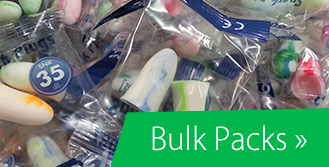Welcome to the Earplug-Store
Soft earplugs, custom earplugs, foam earplugs, silicone earplugs etc .etc. if our wide range confuses you and you would appreciate some help choosing then please email us info@connevans.com
Connevans Earplug-Store is the premier UK home of Mack's earplugs - America's favourite ear plugs in the UK at great prices.
-
BabbleGuard classroom noise indicator
Teach children to self-regulate their noise level and create...
-
Phonak Serenity Choice Hi-end Reusable Earplugs
Phonak Serenity Choice is the high-end hearing protection...
-
Earplugs ideal for use while at work
for use in high noise situations at work and at home, during...
-
Earplugs ideal for use at night while sleeping
Earplugs that are comfortable to wear in bed and effective...
-
Earplugs to block out all the sound
At Connevans we are often asked. “Which are your best earplugs,...
Earplug ratings and how they are calculated
SNR [Single Number Rating] – is number rating used by countries within the European Union and affiliated countries calculated from Assumed Protection Values according to a method given in Annex D of BS EN ISO 4869-2:1995 "Acoustics - Hearing protectors - Part 2: Estimation of effective A-weighted sound pressure levels when hearing protectors are worn". Tests are conducted at independent testing laboratories, using frequencies which are slightly different than those used for the NRR rating. In addition to an overall rating, the SNR further rates protectors in terms of the particular noise environments in which they will be used – H for high-frequency noise environments, M for mid-frequency and L for low-frequency. Note that the HML designation does not refer to noise
level, rather the spectrum of the noise. For example, a protector might be
designated with SNR 26, H=32, M=23, L=14. The estimated attenuation changes according to the noise spectrum of the environment in which the protector is to be worn. The SNR rating is the result of a lengthy mathematical calculation – it gives us a single-number rating of a hearing protector’s attenuation for a specified percentage of the population. The SNR is significantly lower than the average attenuation across all of its test frequencies as the calculation contains correction factors to make it applicable to the broader population. While it is not the perfect real-world measure of attenuation, SNR is a very useful standardized method for describing a hearing protector’s attenuation in a single number. For instant if an environment has an a weighted noise measurement of 100dbA then by using an earplug with an SNR rating of 25db it will reduce the noise to 75db, the precautionary action level is 80dbA, where hearing protection has to be offered and audiometric testing training programs implemented.
NRR [Noise Reduction Rating] – rating is used in the United States, and is accepted for use in a number of other countries. The NRR is an estimate of the amount of protection achievable by 98% of users in a laboratory setting when hearing protectors are properly fitted. The current range of NRR levels available in the U.S. market extends from 0 to 33 decibels. Published by the U.S. Environmental Protection Agency in 1979, the NRR labeling requirement is a standardized format for all hearing protection products distributed in the U.S. The chart showing mean attenuation values and standard deviations at each of the seven test frequencies (from 125 Hz through 8000 Hz).








